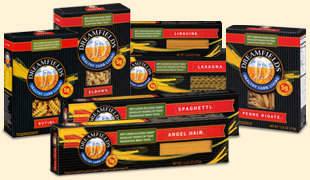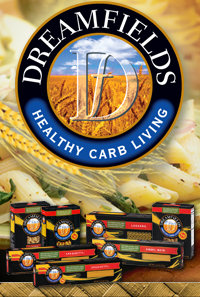|
|
Mike Crowley Interview
(Dreamfields Pasta)

Launched just over two years ago, Dreamfields Pasta is now available in more
than 15,000 supermarkets.
What makes Dreamfields so special you might ask?
Well, its health-promoting pasta with authentic pasta taste and texture, made
with high quality wheat semolina.
It has twice the fiber of regular pasta, is naturally cholesterol free and
has zero grams of trans fat.
Mike Crowley of the Dreamfields Co. which makes Dreamfields Pasta talked with
us about the rise of Dreamfields Pasta.
Q – Mike, what is your title in the co.? What are
your job duties?
A – I’m the President of the company, and as the President of
the company, to be honest, my duties are to keep the team on the field. I’ll
explain that from the point of view that Dreamfields is not what I would consider
a typical company. My background is, I have an engineering background and I
spent about 20 years with Procter and Gamble in various kinds of fields, and
left them in 1990. So, I’ve been gone from them for quite awhile. Dreamfields
as a company is actually an LLC which is made up of four companies. The four
companies that make up Dreamfields is a science co. that is called Tech Com
out of Florida. The guy who is the President of that organization is a guy
by the name of John Anthonson. John is the guy who has the technology which
is actually a patent pending process which we use in Dreamfields. I’ve
known John for 4 or 5 years. I met John when we were both working together
on a project for the late Dr. Atkins, back in like 2001, something like that.
So, Tech Com is one of the cos. in Dreamfields. They basically are the science
people. They’re the people that have the patent. They’re the ones
that came forward with the idea of how to protect carbohydrates. The other
co. in the co. that I was with when I met John was a co. called B-New. B-New
is out of Cincinnati and it is a couple of ex - P and G (Procter and Gamble)
people who have a wealth of understanding of Brand management. Then, a third
co. which is a Swiss co. called Buhler is a co. that is an engineering co.
and an equipment co. It was those three cos. initially, the B-New co., the
Tech Com co., and the Buhler co. that were looking at ways to approve nutrition.
That was really the basis for this. We were trying to say that we felt that
it was necessary for the nutrition of foods to be better than they are now.
And how could we do that? We met sort of through this Atkins thing ‘cause
we were working on low carb kind of products, but that was before the low carb
thing sort of flashed if you will. We were trying to figure out, how could
you make a product that would be good for people that would taste good and
give them some nutritional benefits. And so that’s what really got us
started. Those three cos. were working on that and John Anthonson came forward
with this protect carb technology and what that means is, that the carbohydrates
are still in the food, so you still get the benefits if you will of the taste
and the texture of the carbohydrates, but, you don’t digest them. You
actually pass them through to your large intestine and in that case they firm
out like a fiber does. He had this technology and we were trying to figure
out the best way to use it. We looked at pasta as a good way to go, because
pasta was a relatively low-priced food. Everybody seems to enjoy pasta. It
cuts across almost all the ethnic variations out there. It was a food that
was getting hurt by this whole low carb craze that was going on back then in
2002, 2003. The sales of pasta were going down and the pasta people were attributing
that to the fact that a lot of people were taking pasta off of their menu,
so to speak ‘cause ofthe carbohydrates it contained.
 Q – How did you know there was a market for this
product? The shelves are filled with pasta products. Q – How did you know there was a market for this
product? The shelves are filled with pasta products.
A – Right.But, that weren’t, and this is 2003, very few low carbohydrate
pasta products. And, the ones that were there were the ones made by folks like
by Atkins which werebasically taking out the carbohydrates and replacing them
with proteins like soy and so they tasted terrible, and the texture was terrible.
We did do some consumer testing. My background at P and G tells me
consumer testing is a good thing. So, we did some limited, sort of focus groups
interviews with folks by basically putting the product in front of them and letting
them taste it. At the time we were comparing the Dreamfields product with other
low carb products thatwere out there and there was basically no comparison.
What we wound up doing is comparing Dreamfields with regular pasta’s, ‘cause
that’s really what it tastes like. It tastes like regular pasta. So,
doing some focus groups we figured out that if we could come out with a product
that tasted like regular pasta, look like regular pasta, ‘cause it’s
the same color-----that’s another issue that low carb products had and
even whole grain products had to some extent which they tended to be more of
a brownish color. If we could come out with a product that tasted as good,
had the same color, had the same texture, then people will buy them.
Q – Was it difficult to get Dreamfields placed
in stores like Wal-Mart?
A – Yeah, that’s a good question. Initially-----no. In the beginning
of 2004 when we launched the product, stores like Wal-Mart, Krogers, Publix
were all looking for low carb products, because low carb was taking off and
they were having a very difficult time getting products that they could put
on the shelf that appealed to their consumers over and over again. They would
buy it one time and that was it. They would stop buying them. At this point,
the fourth partner in the business becomes important and that’s Dakota
Growers. Dakota Growers is a pasta co. that’s in North Dakota. It was
originally made up of 1,200 farms. They were basically made up of a group of
farmers trying to figure out the best way to use the wheat they grew, and so
they developed a co-op which is now a corporation, but it’s called Dakota
Growers. Dakota Growers I think is the third largest in the U.S. The pasta
business is changing a little bit. They’re the third largest producer
of pasta in the U.S. They made private label for most of the big accounts,
like Kroger’s and Publix. And so, what we did was, they became our fourth
partner. They became the distribution arm and the sales arm of Dreamfields
and we basically piggy-backed on what they had already established in the trade
as good relationships to all those stores. When we sold the product, we just
took samples of the product into buyers and we let ‘em taste it. Once
they tasted it they said-----wow! It tastes like regular pasta-----so let’s
go ahead and do it. In the beginning of 2004 when we launched we basically
were in national distribution by about June or July 2004, pretty much.
Q – Were there any doubters at Dreamfields when
you launched this product?
A – Yes. People who were familiar with low carb products. There was
a group called the Low Carb Consumer League which was made up of people in
the low carb business and they basically said you really can’t be doing
what you’re doing, because we don’t believe it really works. They
challenged us all the way to what you can do with the national advertising
association in terms of making us prove the product was what we said it was.
The way we did that was we have a clinic in Gainsville, Florida that’s
run by a Doctor Abernathy, as M.D. The clinic is called AMK. They basically
take our product and run an index test on it. They do it for every batch we
make. They feed it to people and they measure the glucose level of those folks
over the next 2 hours. Basically, it forms a graph and based on that you can
calculate the impact it has on blood glucose which then can be backed into
the amount of carbohydrates that actually got digested from the product.
Q – Where did this name Dreamfields come from?
A – The B-New group in doing their focus groups also came up with names
that we tested, and Dreamfields was one of the names that we came up with.
I think the idea was, we were looking for a way to bring in the wheat field
concept and at the same time something for a lot of people was a dream come
true in having a product that actually tasted good and was good for you at
the same time.
Q – Where would you like Dreamfields in 10 years?
A – The technology is good for almost any product that’s made
with flour, because the way it works is we blend what we call fiber-blend,
and if you look at our ingredient statement we have some gum, we have some
pectin, and we have some wheat glutin we blend in with semolina they make the
pasta with. We do some things with the processing that forms this matrix around
the carbohydrate so you don’t digest them. So really our plan is to establish
pasta and get it clearly established as a good brand with Dreamfields and a
technology that people believe and understand and then you can take it to other
products that are made with flour.
© Gary James All Rights Reserved
|




